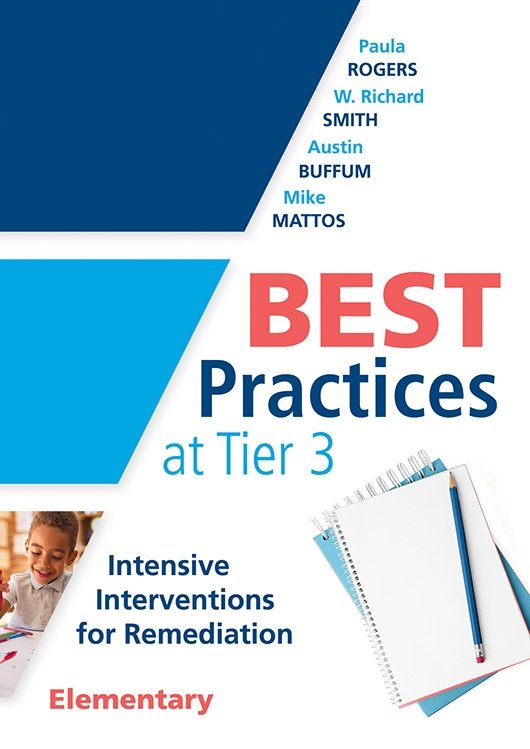Free Reproducibles
Best Practices at Tier 3, Elementary
An RTI model guide for implementing Tier 3 interventions in primary school classrooms
Meet the needs of students who have fallen the furthest behind. Created for elementary school educators, this guide details how to implement intensive interventions at Tier 3 of the RTI at Work™ process. Discover practices and strategies to intervene successfully when students struggle with core content, as well as with foundational skills from previous school years.
Benefits
- Study the critical elements of the RTI at Work™ process.
- Understand the role of teams, specifically the leadership and intervention teams, in implementing Tier 3 interventions.
- Learn how to collaboratively design and deliver instruction to students needing intensive intervention with a multitiered system of support (MTSS).
- Examine the role of assessment at Tier 3 and discover strategies for using assessment data to monitor learning.
- Acquire best practices for delivering intensive behavior interventions according to the RTI at Work process.
TABLE OF CONTENTS
Chapter 1: The Power and Purpose of Tier 3 Intensive Interventions
Chapter 2: The Need for Collective Commitment and Responsibility
Chapter 3: Collaborative Team Structures at Tier 3
Chapter 4: Tier 3 Design to Ensure High Levels of Learning
Chapter 5: Convergent Assessment for Targeting at Tier 3
Chapter 6: Behavior Supports at Tier 3
Chapter 7: Academic Instruction at Tier 3
Chapter 8: Personalized Learning for Teams
Epilogue: Final Thoughts
Appendix: Resources and Tools
REPRODUCIBLES
Chapter 1
Chapter 2
- Figure 2.1: Team Collective Responsibility Survey
- Figure 2.2: Dreams and Commitments
- Figure 2.3: Sample Mantra and Team Actions
Chapter 3
- Table 3.1: Leadership Team and Intervention Team Tier 3 Responsibilities
- Figure 3.1: Building a Site Intervention Team
- Figure 3.2: Critical Questions for Special Education Identification
- Figure 3.3: 1-2-3 Action Planning
- Figure 3.4: Monitoring Our Progress
- Figure 3.5: Roles and Responsibilities for Teams at Tier 3
Chapter 4
Chapter 5
- Figure 5.1: Intervention Team Problem-Solving Process
- Figure 5.3: Sample Learning Progression Used for Individual Goal Setting
- Figure 5.4: Determining Goals for Individual Students
- Figure 5.6: Data Team Template Example
- Figure 5.7: Tier 3 Team Data Analysis Considerations
Chapter 6
- Figure 6.1: Sample Schoolwide Behavior Teaching Matrix
- Figure 6.2: Teaching Considerations for Social and Emotional Learning Skills
- Figure 6.3: Wyatt’s Visual Schedule
- Figure 6.4: Teaching Essential Behavior Skills Team Checklist
- Figure 6.5: Behavior Analysis Protocol
- Figure 6.6: Behavior Intervention Team Meeting Tool
- Figure 6.7: Check-In/Check-Out Weekly Points
- Figure 6.8: Daily Behavior Goal Tracking
- Figure 6.9: Steps to Help Students Learn to Self-Monitor
- Figure 6.10: Individualized Student Behavior Tracker
- Figure 6.11: Steps for Teaching Calm-Down Strategies
- Figure 6.12: Example Choice Board
- Figure 6.13: Safe Place Reflection Sheet
- Figure 6.14: Steps for Teaching Anger Control
- Figure 6.15: Anger Control Strategies
- Figure 6.16: Steps and Considerations for Conflict Resolution
- Behavior Observation Tool
- Individual Behavior Tracking Sheet Example
- Individual Behavior Tracking Sheet
Chapter 7
- Figure 7.1: Steps and Guiding Questions for Instructional Planning
- Figure 7.2: Co-Planning Template
- Figure 7.3: Essential Academic Skills Leadership Team Checklist
- Figure 7.4: Team Data Review—Action Plan
- Table 7.1: High-Leverage Practices for Special Education
- Figure 7.5: Implementing High-Leverage Practices
- Figure 7.6: Student Goal-Setting and Feedback Matrix
- Figure 7.7: My Reading Notepad—Nonfiction Books
- Figure 7.8: Strategies to Remember
Chapter 8
- Figure 8.1: Collaborative Planning for All Students
- Figure 8.2: Leadership Team Reflection Tool
- Figure 8.3: Determining a Grade-Level Learning Progression
- Figure 8.4: Staff Background Sheet
- Figure 8.5: Intervention Team Worksheet
- Figure 8.6: Working the Plan
- Figure 8.7: Who Are Our Learners, and What Are Their Needs?
- Figure 8.8: Who Are Our Learners, and What Are Their Needs? Example

